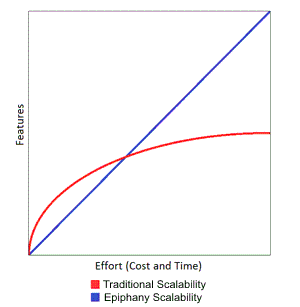One Software, One Vendor, Less Complexity
Problems and Solutions
Epiphany represents a new era of software - a cognitive assistant. Put simply, Epiphany is an intelligent database platform that uses AI (Artificial Intelligence) to allow the database to actually understand itself. A traditional database stores data, and then stores information on how that data relates to other data in the database. Epiphany goes a very important step further. The system intrinsically understands how this data relates to each other, which allows Epiphany to help you store, retrieve, interpret, and communicate data in a way new and unique to the IT world.
Traditional Problems
-
Poor Integration
Lack of integration is the problem facing most organizations when it comes to their data. Organizations have many diverse software needs, like Accounting, Sales and Contact Management, Document Imaging, all with their own applications to manage the data independently. In addition, subsystems like TimeClock, Point of Sale, and websites are managed as separate entities. The problem with this is data needs to be shared between applications. Timeclock and Point of Sale systems need to pass information into accounting. Websites may want to access Document Imaging data, or access prices and quantities from the inventory records in the Accounting system. To do this, interfaces are created, which are expensive to create and maintain, and are only able to translate small amounts of the total amount of available data from one application to another.
Integrated systems represent a solution, but they suffer from other problems.
-
Little Scalability
In order to minimize expensive interfaces and maximize the amount of data available to ancillary systems, some vendors try to integrate as many features into their systems as possible. The problem they end up with is lack of scalability. As the software gets bigger, the effort required to maintain it becomes exponentially larger. New features take longer and longer to develop as more resources are required to hold everything together. This makes the prospect of integrating all of the organizations needs into a single package impossible.
-
Short Product Lifetime
Software becomes obsolete. In order to get the latest features, organizations are frequently scrapping their old software products to get new, resulting in large costs for data conversion, training, and lost productivity. Investments in the old technology are lost completely; they have absolutely no value to the organization once the software is replaced.
Epiphany Solutions
-
Tight Integration
Epiphany solves this in two ways. First, we designed a system that allows us to integrate applications directly with no interfaces. The preferred method of adding new functionality is for us to add that functionally directly to the software, instead of trying to integrate with a third party application. Of course, this is the same goal that other integrated applications have, but they fall short because they haven’t solved the other problems.

-
Infinite Scalability
Scalability is key to the Epiphany system. We have developed an intelligent database that can support as many applications as desired. The Epiphany database is a real-world AI (Artificial Intelligence) platform that is capable of storing any kind of knowledge that we want to put into it. It is a self-aware database that contains not only the raw data but the knowledge of what that data means and how it relates to other data in the system. It was designed from the ground up assuming that ultimately it would contain an unlimited amount of data on an infinite number of subjects. This strict design requirement for scalability was applied to both the data and to the applications that access the data.
-
Eliminate Product Lifetime
If we have a system and can expand infinitely to store all of the data your company will ever need, it stands to reason that system will take an infinite amount of time to complete. We needed to develop a system that didn’t simply plan for obsolescence, but eliminated it. The design of both the database and the software pre-assumed that its technology will become obsolete, and the system knows how to improve and upgrade itself as necessary to keep current without having to end its life and reinvent itself. This has been accomplished knowing full well that no one knows what their future will look like.